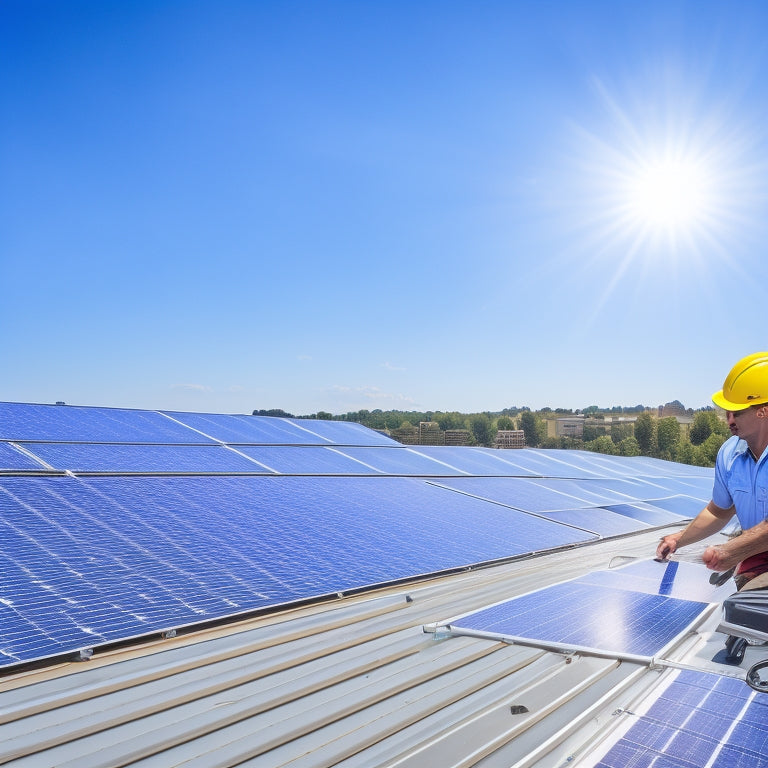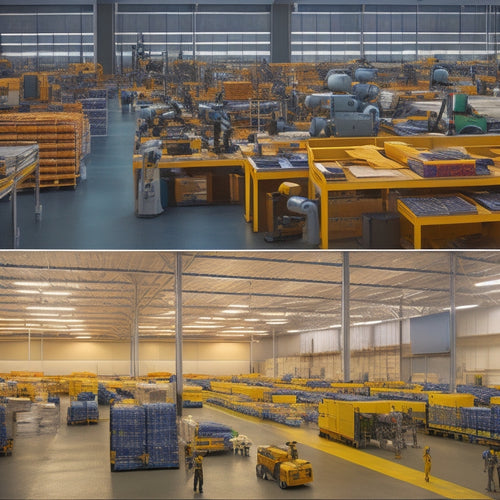
What Does Solar Panel Maintenance Really Cost?
Share
You can expect to pay between $1,500 to $2,500 per year for solar panel maintenance, with costs influenced by your system's size, location, and maintenance frequency. Cleaning and inspection fees, repair and replacement parts, and inverter replacement costs are just a few factors to take into account. Regular inspections can help detect potential issues early, minimizing downtime and maximizing energy production. To optimize your system's performance, it's crucial to understand the nuances of maintenance costs. As you explore your maintenance options, you'll uncover more about what affects your bottom line.
Key Takeaways
• Average annual solar panel maintenance costs range from $1,500 to $2,500, influenced by system size, location, and maintenance frequency.
• Cleaning and inspection fees are necessary for peak energy production, with costs dependent on location and environmental conditions.
• Regular inspections can help minimize repair and replacement costs, which can total $2,000 to $5,000+ for inverter replacements.
• DIY maintenance tasks can save up to 50% on maintenance costs, but professional services may be necessary for more complex issues, costing $150 to $300 per visit.
• Neglecting maintenance can lead to increased costs over time, with costs rising from $500 after 5 years to $2,500 after 25 years.
Average Annual Maintenance Costs
You can expect to pay around $1,500 to $2,500 per year in average annual maintenance costs for a large-scale solar panel system, depending on factors like system size, location, and maintenance frequency. This budget allocation is important to guarantee optimal energy efficiency and maximize your return on investment.
Regular maintenance is essential to prevent potential issues that can lead to energy losses and reduced system performance. To allocate your budget effectively, consider the following factors: system size, maintenance frequency, and location-specific requirements. For instance, larger systems or those installed in harsh environments may require more frequent maintenance, increasing costs.
Cleaning and Inspection Fees
When you factor in the costs of maintaining your solar panel system, you'll need to take into account the fees associated with cleaning and inspection. These services typically include dust and debris removal to guarantee peak energy production, as well as a visual panel inspection to identify any potential issues.
Additionally, an electrical performance check will confirm that your system is operating at its best.
Dust and Debris Removal
Regular cleaning and inspection of solar panels are essential to guarantee maximum energy output, as dust and debris accumulation can result in significant energy losses. You may be wondering, how often should I clean my solar panels? The frequency of cleaning depends on your location and environmental conditions. If you live in a dusty or polluted area, you may need to clean your panels more frequently.
Here's a rough estimate of the cleaning and inspection fees:
| Frequency | Cost per cleaning | Annual Cost |
|---|---|---|
| Quarterly | $100-$200 | $400-$800 |
| Bi-annually | $150-$300 | $300-$600 |
| Annually | $200-$400 | $200-$400 |
Keep in mind that these costs are estimates and may vary depending on your location, panel size, and cleaning method. Additionally, consider the environmental impact of using water for cleaning. Opt for water-efficient cleaning methods or consider using dry cleaning methods to minimize your water footprint. By investing in regular cleaning and inspection, you'll maintain that your solar panels operate at peak performance, maximizing your energy output and reducing your environmental impact.
Visual Panel Inspection
A visual panel inspection is crucial to identify potential issues, such as loose connections or cracks, that could lead to energy losses or safety hazards, and it's usually included in the cleaning and inspection fees. As a solar panel owner, you want to make sure your system operates at peak performance, and a visual inspection helps you do just that.
During the inspection, a professional will examine your panels for signs of wear and tear, checking for dirt buildup, corrosion, and damage to the mounting system. They'll also assess panel aesthetics, ensuring they're clean and free of debris. Some companies are now using inspection robotics to streamline the process, making it more efficient and cost-effective.
Electrical Performance Check
Your solar panel system's electrical performance is thoroughly evaluated during an electrical performance check, which is typically bundled with cleaning and inspection services. This check guarantees your system is operating at peak levels, identifying any potential issues that might be hindering its performance.
During the electrical performance check, a technician will conduct an efficiency analysis to determine how well your system is converting sunlight into electricity. They'll also perform voltage monitoring to identify any anomalies in the electrical output. This detailed assessment helps identify areas for improvement, ensuring you're getting the most out of your solar panel system.
Here's a breakdown of what you can expect from an electrical performance check:
| Service | Cost |
|---|---|
| Efficiency Analysis | $100-$200 |
| Voltage Monitoring | $50-$100 |
| System Performance Report | $150-$300 |
| Recommendations for Improvement | $100-$200 |
| Total | $400-$800 |
Keep in mind that these costs are estimates and may vary depending on the service provider and the complexity of the check. By investing in regular electrical performance checks, you can guarantee your solar panel system operates at peak efficiency, maximizing your energy output and savings.
Repair and Replacement Parts
When it comes to maintaining your solar panel system, you'll need to take into account the cost of repair and replacement parts.
To minimize these costs, you'll want to inspect your panels regularly to catch any issues early. Frequent inspections can help identify potential problems before they become major issues.
Additionally, understanding part failure rates and warranty coverage will help you budget for any necessary repairs or replacements.
Panel Inspection Frequency
Regular solar panel inspections, ideally performed every six months, can help identify potential issues before they escalate into costly repairs or even system failures. By doing so, you'll be able to detect any decline in your panel's condition, guaranteeing efficient energy production.
Scheduling regular inspections allows you to stay on top of your panel's condition, identifying potential issues before they become major problems. It's crucial to inspect your panels regularly to ensure they're operating at peak performance.
You can schedule inspections during periods of low energy production, typically during the spring and fall, to minimize any potential disruption to your energy output.
During these inspections, your maintenance team will assess your panel's condition, checking for signs of wear and tear, cleaning or replacing components as needed. By staying on top of your panel's maintenance, you'll be able to maximize your energy output, reduce repair costs, and extend the lifespan of your solar panel system.
Part Failure Rates
Identifying potential part failures is key to minimizing downtime and maximizing energy production, as a single faulty component can bring your entire system to a standstill. You need to keep a close eye on the performance of your solar panels to catch any issues before they escalate.
Material degradation, for instance, can lead to reduced energy output over time. Weather resistance is another critical factor, as extreme temperatures, humidity, and exposure to the elements can cause components to fail prematurely.
When it comes to part failure rates, you should prioritize monitoring and maintenance to prevent unexpected downtime. Regular inspections can help identify potential issues before they become major problems.
Warranty Coverage
Your warranty coverage provides a financial safety net against unexpected repair and replacement costs, ensuring that your solar panel system remains operational without breaking the bank.
When you purchase a solar panel system, you're likely to receive a warranty that covers repairs and replacements for a certain period. This warranty typically outlines the manufacturer's obligations, including the scope of coverage, duration, and process for filing claims.
However, it's vital to understand the policy limitations and exclusions to avoid unexpected costs. You should carefully review your warranty terms to know what's covered and what's not.
For instance, some warranties mightn't cover damage caused by natural disasters or incorrect installations. It's important to understand the manufacturer's obligations and the process for filing claims to guarantee a smooth and hassle-free experience.
Inverter Replacement Costs
When your solar panel system's inverter reaches the end of its lifespan, typically between 10 to 15 years, you'll need to budget for replacement, which can cost anywhere from $2,000 to $5,000 or more, depending on the type and quality of the new inverter.
This significant expense is unavoidable, as a faulty inverter can severely impact your system's performance, leading to extended periods of system downtime. Inverter lifespan is a critical factor in maintaining a reliable and efficient solar panel system. You should expect to replace your inverter at least once during the system's 25-year lifespan.
Failing to do so can result in reduced energy production, increased maintenance costs, and even safety hazards. During the replacement process, you'll experience system downtime, which can last several days or even weeks, depending on the complexity of the replacement and the availability of replacement parts.
To minimize system downtime and ensure a seamless switch, it's crucial to plan ahead and budget for inverter replacement costs. By doing so, you'll ensure your solar panel system continues to generate power efficiently and reliably.
Panel Cleaning Frequency
Regular cleaning of your solar panels is essential to maintain peak energy production, as dust, dirt, and debris can reduce their efficiency by up to 25%. You'll want to clean your panels regularly to maximize energy output and minimize the environmental impact of your system. The frequency of cleaning depends on your location and the amount of debris your panels are exposed to.
If you live in a dusty or polluted area, you may need to clean your panels every 2-3 months. In cleaner environments, you might get away with cleaning every 6-12 months.
Cleaning your panels regularly can increase your energy efficiency by up to 15%. This means more power for your home and a reduced reliance on non-renewable energy sources. Additionally, cleaning your panels can help extend their lifespan and reduce maintenance costs in the long run.
DIY Maintenance Cost Savings
By taking matters into your own hands, you can save up to 50% on maintenance costs by performing routine DIY tasks, such as cleaning and inspecting your solar panels.
As a solar panel owner, you're likely motivated by the pursuit of energy independence. By investing in the right tools, you can take control of your system's maintenance and reduce your reliance on professionals. A good quality solar panel cleaning kit, for instance, can be a worthwhile investment, allowing you to keep your panels clean and efficient.
Regular inspections can also help you identify potential issues before they become major problems. By performing these tasks yourself, you'll not only save money on maintenance costs but also gain a deeper understanding of your system and how to optimize its performance.
With the right tools and a bit of know-how, you can take charge of your solar panel maintenance and enjoy the benefits of energy independence.
Professional Maintenance Pricing
To guarantee peak performance when evaluating, it's crucial to consider the scope of work involved. A typical maintenance visit may include tasks such as inspecting the panels, cleaning, and performing minor repairs. If more extensive repairs or replacements are required, the costs will naturally increase.
You'll likely pay between $150 to $300 per visit for professional solar panel maintenance services, depending on the frequency and scope of the work. This cost includes labor rates, which can vary depending on the location, complexity of the job, and the service provider's expertise. On average, labor rates for solar panel maintenance range from $75 to $200 per hour.
To get a better understanding of the costs, it's vital to evaluate the scope of work involved. A typical maintenance visit may include tasks such as inspecting the panels, cleaning, and performing minor repairs. If more extensive repairs or replacements are required, the costs will naturally increase.
Many service providers offer service contracts, which can help spread the cost over time. These contracts often include regular maintenance visits, priority scheduling, and discounted labor rates. By investing in a service contract, you can budget for maintenance costs more effectively and ensure your solar panels operate at peak levels. Be sure to carefully review the contract terms and conditions to ensure you understand what's included and what's not.
Maintenance Costs Over Time
As your solar panel system ages, maintenance costs can escalate over time, especially if left unchecked, making it essential to factor in these expenses into your long-term budget. You'll need to take into account the impact of wear and tear on your system's energy efficiency and plan accordingly.
| Year | Maintenance Cost | Energy Efficiency Impact |
|---|---|---|
| 5 | $500 | 2% decline |
| 10 | $1,000 | 5% decline |
| 15 | $1,500 | 8% decline |
| 20 | $2,000 | 12% decline |
| 25 | $2,500 | 15% decline |
As the table shows, maintenance costs can add up over time, and neglecting regular maintenance can lead to significant declines in energy efficiency. To ensure top performance and minimize cost projections, it's essential to prioritize maintenance and factor in these expenses into your long-term budget. By doing so, you can maximize your system's energy efficiency and minimize the financial burden of maintenance costs.
Extended Warranty Options
Investing in extended warranty options can provide a financial safety net against unexpected repair and replacement costs, guaranteeing your solar panel system operates at peak performance without breaking the bank. You'll have peace of mind knowing you're protected from sudden expenses that can disrupt your budget.
Premium Protection plans, for instance, often cover parts and labor costs for a specified period, usually up to 10 or 15 years. This can be a wise investment, especially for commercial-scale solar installations where downtime can be costly.
When considering extended warranty options, look for providers that offer thorough Extended Coverage. This typically includes protection against defects, malfunctions, and environmental factors like extreme weather conditions. Be sure to review the terms and conditions carefully, as some warranties may have specific requirements or limitations.
Frequently Asked Questions
Can I Claim Maintenance Costs on My Taxes?
You can claim maintenance costs on your taxes as a deduction, and since you've invested in solar panels, you're eligible for energy credits, which can greatly reduce your taxable income, boosting your savings.
Do Maintenance Costs Vary by Solar Panel Brand?
You'll find that maintenance costs do vary by solar panel brand, as some brands prioritize quality and durability, impacting maintenance needs, making a brand comparison essential to understanding your specific cost burden.
Can I Perform Maintenance During Peak Sun Hours?
You shouldn't perform maintenance during peak sun hours, as it reduces energy output; instead, schedule maintenance during off-peak hours using Solar Scheduling, ensuring Panel Optimization and maximizing your energy harvest.
Will Maintenance Void My Solar Panel Warranty?
Like a master chef reviewing a recipe, you're wise to take into account warranty implications. When performing maintenance, make sure you follow manufacturer requirements to avoid warranty exclusions, as neglecting these can void your coverage, leaving you high and dry.
Are Maintenance Costs the Same for Residential and Commercial Systems?
You'll find that maintenance costs differ between residential and commercial systems due to system comparisons showing larger commercial systems requiring more extensive maintenance, resulting in cost disparities that can add up quickly.
Related Posts
-

5 Best Practices for Long-Lasting Sustainable Batteries
To maximize the lifespan of your batteries, you should optimize charging cycles by maintaining a charge level between...
-

Why Are Online Prices for Panels So Low?
When you buy panels online, you're often taking advantage of a combination of factors that drive prices lower. You're...
-

What Eco-Friendly Vehicles Can You Buy Online Today?
You can now browse and buy a wide range of eco-friendly vehicles online, from electric cars with solar roofs to solar...


